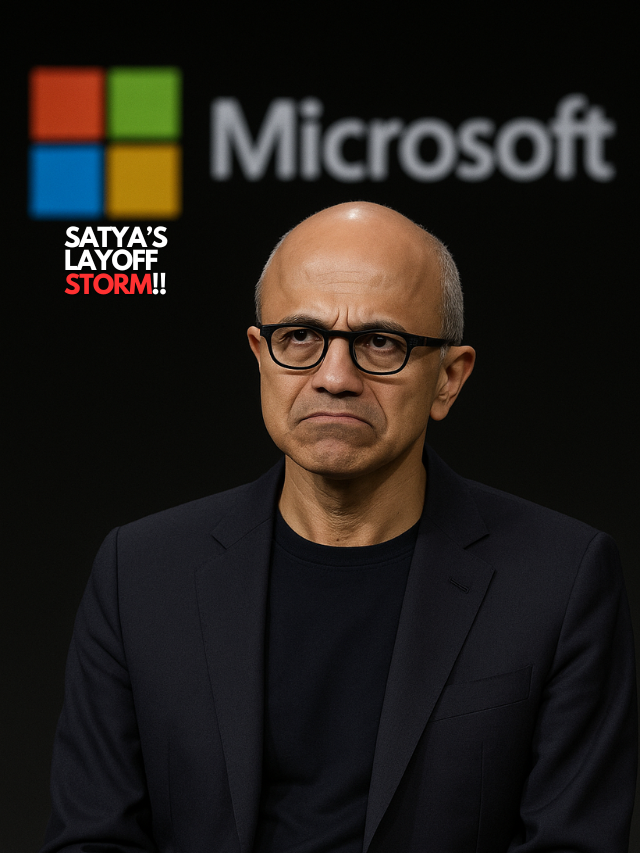Summary
- Microsoft has announced nearly 6,000 layoffs in 2025, triggering widespread backlash against CEO Satya Nadella for perpetuating a “layoff culture.”
- Critics cite Nadella’s layoff history since 2014, while defenders point to massive stock gains and strategic restructuring, especially in India.
- The controversy underscores broader unrest in the tech sector, which has shed over 53,000 jobs in the first five months of 2025 alone.
Satya Nadella’s Halo Is Slipping—and Tech Workers Are Furious
Microsoft’s CEO Satya Nadella is facing his fiercest online backlash in years—not for a product flop, not for a failed acquisition, but for what employees and observers are calling an entrenched “layoff culture.” With nearly 6,000 jobs slashed this year, despite strong financials, even loyalists are questioning whether the leadership halo that defined Nadella’s rise is now stained with structural cruelty.
The uproar began with a viral post on TeamBlind, the anonymous workplace platform, accusing Nadella of laying off over 50,000 employees during his 10-year tenure. “He started with 18K in 2014. He did it again in 2018, 2023, 2024, and now 2025. This cycle will continue till he leaves,” the post claimed. What followed was a digital firestorm—part indictment, part debate, part existential crisis about what corporate leadership should look like in the AI era.
To critics, the optics are brutal: a $3 trillion company, flush with profit, is cutting thousands to appease shareholders. To defenders, Nadella is merely adapting the company to an AI-driven future, streamlining operations, and outpacing rivals.
But the bigger question is no longer just about Microsoft. It’s about whether layoffs are now a feature—not a bug—of modern tech capitalism.
A Microsoft engineer disrupted CEO Satya Nadella during the 2025 Build conference and emailed thousands of employees, accusing the company of profiting from Israel’s genocide in Gaza.
— TRT World (@trtworld) May 20, 2025
Hear what one of the organisers told TRT World pic.twitter.com/FRYnQrC8wC
The Numbers, the Justifications, and the Growing Cynicism
- Microsoft’s 2025 layoffs affect around 3% of its global workforce, one of the largest cuts since 2023.
- The layoffs come despite rising profits, strong AI adoption, and record stock performance.
- Critics say the timing betrays a “profit-at-any-cost” mindset and erodes workplace trust.
- Nadella is being accused of normalizing layoffs as a business model—especially during high-margin years.
Tech is bleeding talent in 2025. Over 53,000 tech jobs have been lost globally in just five months, with Microsoft, Meta, Intel, CrowdStrike, and Northvolt leading the carnage. Microsoft’s latest cut stands out—not just for its scale, but for its paradox. The company isn’t struggling; it’s soaring.
Investors have welcomed the restructuring. Microsoft’s stock continues to climb. But employees, especially in the U.S., feel expendable. One viral comment read: “So what do you want? Free money and no work? Become a CEO first.” Another, more sobering: “We’re not family, we’re cost centers.”
This cultural cynicism is amplified by reports of continued stack ranking, alleged favoritism, and regional hiring imbalances—especially in favor of India.
India’s Tech Boom Amid U.S. Job Cuts
- Some netizens defended Nadella’s hiring in India, pointing to 200,000 jobs created in Hyderabad and other hubs.
- Critics allege regional bias and uneven distribution of opportunity within the company.
- Microsoft has grown aggressively in India, where labor is cheaper and AI talent is abundant.
- The internal rift reflects a broader global talent realignment in the post-pandemic tech industry.
As layoffs hit Seattle, San Francisco, and other U.S. tech hubs, Indian expansion continues. Multiple posts defended Nadella by pointing out that Microsoft has invested heavily in Indian R&D centers, particularly in Hyderabad. “How many did he hire? What’s the percentage of U.S. employees now vs. 10 years ago?” asked one user.
While that may be true, it doesn’t blunt the emotional impact for those laid off in the U.S. or Europe. Critics argue that even if the India hiring strategy is economically rational, it is ethically fraught when juxtaposed with thousands of domestic job losses in the West.
This points to a deeper fault line: a tech world increasingly global in structure, but emotionally unmoored from the people who built it. Layoffs in 2025 aren’t just operational—they’re cultural resets, done without apology.
When Efficiency Becomes Identity
The core tension surrounding Satya Nadella isn’t just about numbers—it’s about narrative. For years, Nadella was the CEO who revitalized Microsoft’s culture, who brought empathy and openness to a historically rigid organization. Under his watch, the company embraced open-source collaboration, inclusive design, and cloud-first innovation.
But today, critics argue that the same CEO has institutionalized layoffs as a permanent lever for quarterly performance. In their view, Microsoft has traded culture for calculation—and Nadella’s decade-long legacy is becoming one of paradox.
Supporters still insist the layoffs are strategic, not cynical. They cite AI disruption, over-hiring during the pandemic, and a shift toward high-impact teams. But for many on the ground, the message is clearer: performance is no longer enough. You’re only secure until the next quarterly review.
A CEO Between Two Eras
Satya Nadella is no Steve Ballmer—and that’s the point. While Ballmer oversaw flat stock prices and stagnation, Nadella’s Microsoft multiplied its market cap elevenfold. But Ballmer, say some, never built a layoff machine. “Bring back Steve,” one post ironically quipped. “At least he didn’t hide behind empathy when he cut.”
The deeper truth may be that neither model fits the world of 2025. The age of stable corporate employment is over. Efficiency now trumps loyalty. AI accelerates restructuring faster than HR can prepare FAQs. And CEOs, even those with clean reputations, are no longer judged solely by strategy—but by how they wield power during prosperity.
In that sense, Nadella is not just a man under fire. He’s a symbol of tech’s new contradictions: profitable yet merciless, admired yet distrusted, visionary yet robotic.



